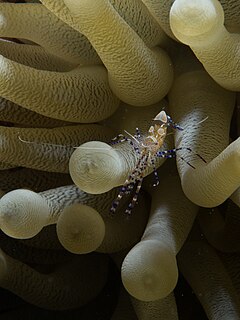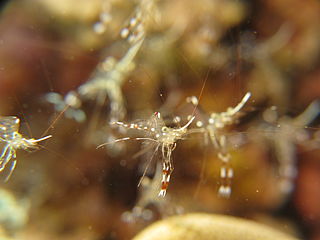
The wrasses are a family, Labridae, of marine fish, many of which are brightly colored. The family is large and diverse, with over 600 species in 81 genera, which are divided into 9 subgroups or tribes. They are typically small fish, most of them less than 20 cm (7.9 in) long, although the largest, the humphead wrasse, can measure up to 2.5 m (8.2 ft). They are efficient carnivores, feeding on a wide range of small invertebrates. Many smaller wrasses follow the feeding trails of larger fish, picking up invertebrates disturbed by their passing. Juveniles of some representatives of the genera Bodianus, Epibulus, Cirrhilabrus, Oxycheilinus, and Paracheilinus hide among the tentacles of the free-living mushroom corals & Heliofungia actiniformis.

The false cleanerfish is a species of combtooth blenny, a mimic that copies both the dance and appearance of Labroides dimidiatus, a similarly colored species of cleaner wrasse. It likely mimics that species to avoid predation, as well to occasionally bite the fins of its victims rather than consume parasites. Most veiled attacks occur on juvenile fish, as adults that have been attacked in the past may avoid or even attack A. taeniatus.

Lysmata amboinensis is an omnivorous shrimp species known by several common names including the Pacific cleaner shrimp. It is considered a cleaner shrimp as eating parasites and dead tissue from fish makes up a large part of its diet. The species is a natural part of the coral reef ecosystem and is widespread across the tropics typically living at depths of 5–40 metres (16–131 ft).

Stenopus hispidus is a shrimp-like decapod crustacean belonging to the infraorder Stenopodidea. Common names include banded coral shrimp and banded cleaner shrimp.

The spotted cleaner shrimp, is a kind of cleaner shrimp common to the Caribbean Sea. These shrimp live among the tentacles of several species of sea anemones. They sway their body and wave their antennae in order to attract fish from which they eat dead tissue, algae and parasites.

A cleaning station is a location where aquatic life congregate to be cleaned by smaller creatures. Such stations exist in both freshwater and marine environments, and are used by animals including fish, sea turtles and hippos.

Lysmata debelius is a species of cleaner shrimp indigenous to the Indo-Pacific. It is popular in the aquarium trade, where it is known as the fire shrimp, blood shrimp or scarlet cleaner shrimp.

Cleaner shrimp is a common name for a number of swimming decapod crustaceans, that clean other organisms of parasites. They belong to any of three families, Hippolytidae, Palaemonidae, and Stenopodidae . The last of these families is more closely related to lobsters and crabs than it is to the remaining families. The term "cleaner shrimp" is sometimes used more specifically for the family Hippolytidae and the genus Lysmata.

Cleaner fish are fish that show a specialist feeding strategy by providing a service to other species, referred to as clients, by removing dead skin, ectoparasites, and infected tissue from the surface or gill chambers. This example of cleaning symbiosis represents mutualism and cooperation behaviour, an ecological interaction that benefits both parties involved. However, the cleaner fish may consume mucus or tissue, thus creating a form of parasitism called cheating. The client animals are typically fish of a different species, but can also be aquatic reptiles, mammals, or octopuses. A wide variety of fish including wrasse, cichlids, catfish, pipefish, lumpsuckers, and gobies display cleaning behaviors across the globe in fresh, brackish, and marine waters but specifically concentrated in the tropics due to high parasite density. Similar behavior is found in other groups of animals, such as cleaner shrimps.

Acanthurus coeruleus is a surgeonfish found commonly in the Atlantic Ocean. It can grow up to 39 centimetres (15 in) long. Common names include Atlantic blue tang, blue barber, blue doctor, blue doctorfish, blue tang, blue tang surgeonfish, yellow barber, and yellow doctorfish.

The bluestreak cleaner wrasse, Labroides dimidiatus, is one of several species of cleaner wrasses found on coral reefs from Eastern Africa and the Red Sea to French Polynesia. Like other cleaner wrasses, it eats parasites and dead tissue off larger fishes' skin in a mutualistic relationship that provides food and protection for the wrasse, and considerable health benefits for the other fishes.

Elacatinus is a genus of small marine gobies, often known collectively as the neon gobies. Although only one species, E. oceanops, is technically the "neon goby," because of their similar appearance, other members of the genus are generally labeled neon gobies, as well. Except for a single East Pacific species, all reside in warmer parts of the West Atlantic, including the Caribbean and Gulf of Mexico. They are known for engaging in symbiosis with other marine creatures by providing them cleaning service that consists of getting rid of ectoparasites on their bodies. In return, Elacatinus species obtain their primary source of food, ectoparasites.

Ancylomenes magnificus, also known as the Magnificent Anemone Shrimp, is a species of cleaner shrimp common to the Western Pacific Ocean at depths of 3–29 metres (10–95 ft). They are commonly found on stony coral, Catalaphyllia and the sea anemone, Dofleinia armata.

Elacatinus puncticulatus is a species of goby from the eastern central Pacific Ocean where it is found on reefs from the Gulf of California to Ecuador. This species occurs at depths of from 2 to 6 m, usually in association with the sea urchin Eucidaris thouarsii. It grows to a standard length of 4.4 cm (1.7 in). It occasionally is found in the aquarium trade.

Coral reef fish are fish which live amongst or in close relation to coral reefs. Coral reefs form complex ecosystems with tremendous biodiversity. Among the myriad inhabitants, the fish stand out as colourful and interesting to watch. Hundreds of species can exist in a small area of a healthy reef, many of them hidden or well camouflaged. Reef fish have developed many ingenious specialisations adapted to survival on the reefs.

Lysmata is a genus of shrimp in the infraorder Caridea, the caridean shrimp. The genus belongs to the family Lysmatidae. Lysmata are popular ornamental shrimp in the marine aquarium trade for their bright color patterns, interesting behaviors, and ability to control certain aquarium pests such as sea anemones of the genus Aiptasia. They are known to command high prices on the pet market.

Urocaridella antonbruunii, common names clear cleaner shrimp or red-white cleaner shrimp, is a species of shrimp belonging to the family Palaemonidae. It was described by A. J. Bruce in 1967. It is one of the species that are known as cleaner shrimps.

Ancylomenes pedersoni, sometimes known as Pederson's shrimp, is a species of cleaner shrimp. It is part of the genus Ancylomenes and was described in 1958 by Fenner A. Chace Jr. as Periclimenes pedersoni. Ancylomenes pedersoni is found in the Caribbean Sea, often associated with a sea anemone, at depths of 1 to 15 metres. They are often found on the reefs off Bermuda.
Stenopus scutellatus, commonly known as the gold coral banded shrimp or golden coral shrimp, is a boxer shrimp, a shrimp-like decapod crustacean belonging to the family Stenopodidae. It is found in suitable habitats in the western Atlantic and the Caribbean Sea.

The Hawaiian cleaner wrasse or golden cleaner wrasse, is a species of wrasse found in the waters surrounding the Hawaiian Islands. The fish is endemic to Hawaii. These cleaner fish inhabit coral reefs, setting up a territory referred to as a cleaning station. They obtain a diet of small crustacean parasites by removing them from other reef fish in a cleaning symbiosis.



















